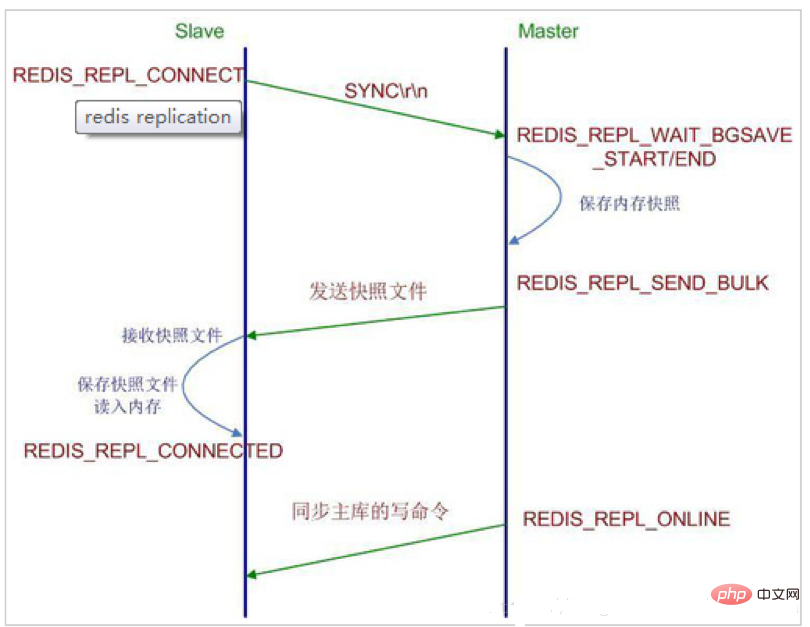
Some methods to implement the redis high availability mechanism:
Ensuring the redis high availability mechanism requires redis master-slave replication and redis persistence Mechanism, sentinel mechanism, keepalived, etc. support.
The functions of master-slave replication: data backup, read-write separation, distributed clustering, high availability, downtime fault tolerance mechanism, etc. (Recommended learning: Redis video tutorial)
redis master-slave replication principle
First of all, master-slave replication needs to be divided into two roles : master (master) and slave (slave), note: redis only supports one master, unlike Mysql and Nginx master-slave replication, which can have multiple masters and multiple slaves.
1. The replication function of redis supports data synchronization between multiple databases. One is the master database (master) and the other is the slave database (slave). The master database can perform read and write operations. When a write operation occurs, the data is automatically synchronized to the slave database. The slave database is generally read-only and receives For data synchronized from the master database, a master database can have multiple slave databases, while a slave database can only have one master database.
2. The replication function of redis can effectively separate the reading and writing of the database and improve the load capacity of the server. The master database mainly performs write operations, while the slave database is responsible for read operations.
The process of full synchronization of master-slave replication: see the figure below

Redis master-slave replication can be based on whether it is full Divided into full synchronization and incremental synchronization
Redis full replication generally occurs during the Slave initialization phase. At this time, the Slave needs to copy all the data on the Master.
Full synchronization process:
1: When a slave database starts, the sync command will be sent to the master database,
2: The master database receives After reaching the sync command, it will start to save the snapshot in the background (perform RDB operation), and use the cache area to record all subsequent write operations
3: When the master server snapshot is saved, redis will send the snapshot file to the slave database.
4: After receiving the snapshot file from the database, all old data will be discarded and the received snapshot will be loaded.
5: After the master server snapshot is sent, it starts sending the write command in the buffer to the slave server.
6: The slave server completes loading the snapshot, starts receiving command requests, and executes write commands from the master server buffer.
Incremental synchronization process:
Redis incremental replication refers to the process in which the write operations that occur on the master server are synchronized to the slave server when the slave starts to work normally after initialization.
The process of incremental replication is mainly that every time the master server executes a write command, it will send the same write command to the slave server, and the slave server receives and executes the received write command.
Selection of full and incremental synchronization of Redis master-slave replication:
When the master-slave server is just connected, full synchronization will be performed first; after full synchronization is completed, then Perform incremental synchronization. Of course, if necessary, the slave can initiate full synchronization at any time. The redis strategy is that, no matter what, incremental synchronization will be attempted first, and if unsuccessful, the slave machine will be required to perform full synchronization.
How to configure redis master-slave replication?
修改从服务器redis/conf中的redis.conf文件 修改IP地址和端口号为主服务器的IP和端口 slaveof 10.211.55.9 6379 masterauth 123456--- 如果主redis服务器配置了密码,则需要配置
You only need to configure redis.conf of the slave server, and no configuration is required for the master server. You can verify whether it is successful by 1. First log in to the main server redis-cli client and enter info.
If the role shows master and slave0 can display the IP of the slave server normally, it means that the master-slave service configuration is successful, the master-slave replication configuration is successful, and the read-write separation is also achieved at the same time. Don’t believe it? Take a look and try it Can your slave server still perform write operations?
The answer is: No. There are only read operations from the server!
For more Redis-related technical articles, please visit the Redis Getting Started Tutorial column to learn!
The above is the detailed content of How to implement a highly available redis cluster. For more information, please follow other related articles on the PHP Chinese website!
 Commonly used database software
Commonly used database software
 What are the in-memory databases?
What are the in-memory databases?
 Which one has faster reading speed, mongodb or redis?
Which one has faster reading speed, mongodb or redis?
 How to use redis as a cache server
How to use redis as a cache server
 How redis solves data consistency
How redis solves data consistency
 How do mysql and redis ensure double-write consistency?
How do mysql and redis ensure double-write consistency?
 What data does redis cache generally store?
What data does redis cache generally store?
 What are the 8 data types of redis
What are the 8 data types of redis